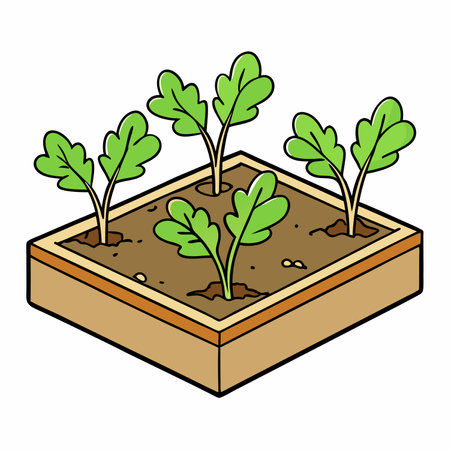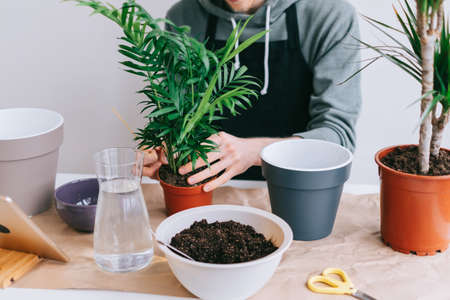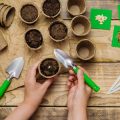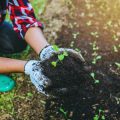Understanding Indoor Plant Soil Needs
When it comes to growing healthy indoor plants, choosing the right soil mix is just as important as watering and lighting. Unlike outdoor plants, houseplants have specific needs when it comes to soil composition, drainage, and aeration. Regular garden soil simply won’t cut it indoors—it can be too dense, poorly draining, and may introduce pests or diseases into your home.
Why Garden Soil Doesn’t Work Indoors
Garden soil is designed for use in open-air environments where water drains freely and natural organisms help break down organic matter. Indoors, this type of soil can become compacted, suffocate roots, retain too much moisture, and promote root rot. That’s why specially formulated potting mixes are essential for thriving indoor plants.
Key Components of Indoor Potting Mixes
A good indoor soil mix should balance three core elements: proper drainage, good aeration, and nutrient retention. Heres a breakdown of common ingredients you’ll find in high-quality indoor plant soils:
| Component | Purpose |
|---|---|
| Peat Moss or Coconut Coir | Retains moisture without becoming soggy; adds lightness to the mix |
| Perlite or Pumice | Improves drainage and increases airflow around roots |
| Vermiculite | Helps with moisture retention and nutrient absorption |
| Compost or Worm Castings | Adds nutrients to support plant growth |
| Bark Fines or Sand | Enhances texture and drainage depending on the plant’s needs |
The Role of Drainage and Aeration
Poor drainage is one of the most common reasons indoor plants struggle. Without enough air pockets in the soil, roots can’t breathe properly and may start to rot. Ingredients like perlite and coarse sand create space for oxygen to circulate while allowing excess water to flow out easily. This is especially important for plants like succulents or snake plants that are sensitive to overwatering.
Selecting Soil Based on Plant Type
Different houseplants have different soil preferences. For example:
| Plant Type | Recommended Soil Characteristics |
|---|---|
| Cacti & Succulents | Sandy, fast-draining mix with extra perlite or pumice |
| Tropical Plants (e.g., Monsteras) | Rich organic mix with peat moss and bark for aeration |
| Aroids (e.g., Philodendrons) | Chunky mix with orchid bark, perlite, and coco coir for airflow |
| Ferns & Moisture-Loving Plants | Moisture-retentive mix with peat moss and vermiculite |
The Takeaway on Indoor Soil Needs
Your indoor plants soil isnt just “dirt”—its their entire ecosystem. Using the right blend helps ensure your plants get the oxygen, water drainage, and nutrients they need to grow strong and beautiful inside your home.
2. Key Ingredients in the Perfect Indoor Soil Mix
Creating a healthy and supportive environment for your indoor plants starts with choosing the right soil mix. Not all soils are created equal, and the ingredients you choose can make a big difference in how well your houseplants grow. Let’s explore some of the most popular and effective components used in indoor potting mixes, and why they’re important for plant health.
Peat Moss
Peat moss is one of the most common base materials in potting soil. It’s lightweight, retains moisture well, and provides good air space around roots, which helps prevent root rot. However, it’s slightly acidic, so it works best for acid-loving plants like ferns or African violets. Peat moss is also not renewable, so many eco-conscious gardeners look for alternatives.
Coconut Coir
Coconut coir is made from the fibrous husks of coconuts and is considered a more sustainable alternative to peat moss. It has similar water-retention properties but with a more neutral pH level, making it suitable for a wider variety of plants. It also improves soil aeration and structure.
Perlite
Perlite is a lightweight, white volcanic rock that’s been heated until it expands. It doesn’t hold water but instead helps keep the soil loose and aerated. This prevents compaction and supports healthy root development by improving drainage. You’ll find perlite in almost every commercial potting mix.
Vermiculite
Vermiculite is another mineral thats heated to expand into lightweight particles. Unlike perlite, vermiculite holds both water and nutrients very well, slowly releasing them as the plant needs them. It’s ideal for moisture-loving plants or for seed starting mixes.
Comparison of Soil Mix Ingredients
| Ingredient | Main Benefits | Best For | Sustainability |
|---|---|---|---|
| Peat Moss | Moisture retention, light texture | Acid-loving plants (ferns, African violets) | Low (not renewable) |
| Coconut Coir | Moisture retention, neutral pH, eco-friendly | Most indoor plants | High (renewable) |
| Perlite | Aeration, drainage improvement | Cacti, succulents, general use | Moderate (mined material) |
| Vermiculite | Nutrient & water retention | Seedlings, moisture-loving plants | Moderate (mined material) |
Selecting the right combination of these ingredients depends on your specific plants needs. For example, succulents thrive in well-draining mixes heavy on perlite, while tropical houseplants do better with more coconut coir or peat moss to retain moisture. By understanding what each ingredient does, you can customize your own potting mix or choose a commercial blend that best suits your indoor garden.

3. Top Soil Mixes for Popular Indoor Plants
Choosing the right soil mix is key to helping your indoor plants grow strong and healthy. Different houseplants have different needs, so its important to match the soil to the plant. Below, we’ve rounded up the best ready-made and DIY soil mixes for some of the most popular indoor plants in the U.S., including succulents, orchids, ferns, and fiddle leaf figs.
Succulents
Succulents like aloe vera and jade plants need fast-draining soil to prevent root rot. Look for a gritty mix that doesn’t hold too much moisture.
Recommended Soil Mix:
- Ready-Made: Miracle-Gro Cactus, Palm & Citrus Potting Mix
- DIY Mix: 2 parts coarse sand or perlite, 2 parts potting soil, 1 part pumice or crushed granite
Orchids
Orchids require excellent air circulation around their roots. They thrive in chunky, well-ventilated media instead of traditional soil.
Recommended Soil Mix:
- Ready-Made: Better-Gro Orchid Bark Mix
- DIY Mix: 4 parts fir bark, 1 part perlite, 1 part charcoal
Ferns
Ferns like Boston ferns prefer a moist but well-draining mix thats rich in organic matter.
Recommended Soil Mix:
- Ready-Made: Espoma Organic Potting Mix (with added peat moss)
- DIY Mix: 2 parts peat moss or coco coir, 1 part perlite, 1 part compost
Fiddle Leaf Figs
This trendy houseplant needs a light and airy mix that holds some moisture but drains well to avoid soggy roots.
Recommended Soil Mix:
- Ready-Made: FoxFarm Ocean Forest Potting Soil
- DIY Mix: 2 parts potting soil, 1 part perlite, 1 part coconut coir or peat moss
Quick Comparison Table
| Plant Type | Best Ready-Made Mix | Simple DIY Recipe |
|---|---|---|
| Succulents | Miracle-Gro Cactus Mix | 2 sand + 2 potting soil + 1 pumice |
| Orchids | Better-Gro Orchid Bark | 4 bark + 1 perlite + 1 charcoal |
| Ferns | Espoma Organic Potting Mix | 2 peat/coco + 1 perlite + 1 compost |
| Fiddle Leaf Figs | FoxFarm Ocean Forest | 2 potting soil + 1 perlite + 1 coir/peat |
Selecting the right soil mix makes all the difference when it comes to healthy indoor plants. Whether you choose a convenient store-bought blend or make your own at home, tailoring your soil to your plants specific needs will help them thrive year-round.
4. How to Customize Your Own Indoor Soil Mix
Creating your own indoor soil mix at home is a great way to ensure your plants get exactly what they need to thrive. Different plants have different preferences when it comes to drainage, moisture retention, and nutrients. Plus, depending on where you live in the U.S., your local climate—like dry desert air or high humidity—can affect how well your indoor plants grow. Here’s how you can tweak your soil mix for better plant health and growth.
Understand Your Plants Needs
Start by identifying what type of plant youre potting. A cactus has very different needs than a peace lily or a fern. Heres a quick guide to common plant categories and what they typically need in a soil mix:
| Plant Type | Preferred Soil Traits | Suggested Additives |
|---|---|---|
| Cactus & Succulents | Fast-draining, low moisture retention | Sand, perlite, pumice |
| Tropical Plants (e.g., Monsteras) | Aerated, well-draining but moisture-holding | Coco coir, orchid bark, perlite |
| Ferns & Calatheas | Moisture-retentive yet breathable | Sphagnum moss, peat moss, vermiculite |
| Herbs & Edibles | Nutrient-rich, balanced moisture | Compost, worm castings, coconut coir |
Tweak Based on Local Climate Conditions
If you live in a dry climate like Arizona or Nevada, your indoor air is likely low in humidity. In that case, adding more moisture-retentive elements such as peat moss or coco coir can help keep roots from drying out too quickly. On the flip side, if youre in a humid region like Florida or Louisiana, you’ll want a lighter mix with excellent drainage to prevent root rot—think more perlite and orchid bark.
Adjust for Common Indoor Challenges
Poor Lighting Conditions
If your home doesn’t get much natural light, especially during winter months in northern states, you may want to use soil mixes that don’t stay soggy for too long. Less light usually means slower growth and less water uptake. A well-aerated mix with extra drainage can help prevent overwatering issues.
Low Humidity Indoors
Dry indoor air—common when heating systems are running—can lead to crispy leaves and unhappy plants. Use ingredients like vermiculite or add a top layer of sphagnum moss to retain surface moisture around sensitive roots.
Create Your Go-To Base Mix First
A good starting point for most houseplants is a 3-part base soil mix:
- 2 parts potting soil: Provides basic nutrients and structure.
- 1 part perlite: Improves drainage and aeration.
- 1 part coco coir or peat moss: Helps with moisture retention.
You can then customize this base depending on the plant’s specific needs using the table above as a guide.
A Few Extra Tips:
- Sterilize old soil: If reusing soil from another plant, bake it at 180°F for 30 minutes to kill pests and pathogens.
- Add slow-release fertilizer: For long-term nutrient support without frequent feeding.
- Avoid garden soil: It’s too heavy and may contain outdoor pests or diseases not suited for indoor environments.
By learning how to adjust your soil mix based on plant type, local conditions, and common indoor issues, you’re setting yourself up for healthy and happy houseplants year-round!
5. Proper Soil Care and Maintenance Tips
Keeping your indoor plant soil in top shape is just as important as choosing the right mix in the first place. Even the best soil can become compacted or lose nutrients over time, which can affect your plant’s health and growth. Heres how to care for your soil to keep your houseplants thriving year-round.
How Often Should You Refresh Potting Soil?
Refreshing your potting mix helps prevent nutrient depletion and improves drainage. Heres a simple guideline:
| Plant Type | Soil Refresh Frequency |
|---|---|
| Fast-growing plants (e.g. Pothos, Spider Plant) | Every 12 months |
| Slow-growing plants (e.g. Snake Plant, ZZ Plant) | Every 18–24 months |
| Cacti & Succulents | Every 2 years |
Signs Your Soil Needs Attention
If youre unsure whether its time to replace or amend your soil, watch out for these red flags:
- Compacted soil: Water sits on top or drains very slowly.
- Unpleasant odor: A sour or moldy smell could signal root rot or poor drainage.
- Salt or mineral buildup: White crust on the surface from hard water or fertilizer residue.
- Poor plant performance: Yellowing leaves, stunted growth, or wilting despite regular care.
Tips for Encouraging Healthy Root Development
A healthy root system is key to a thriving indoor plant. Use these tips to support strong roots:
- Use a well-draining soil mix tailored to your plant type (e.g., cactus mix for succulents).
- Avoid overwatering—let the top inch of soil dry out before watering most houseplants.
- Add perlite, pumice, or orchid bark to improve aeration if the soil feels too dense.
- Consider repotting into a slightly larger container if roots are circling the bottom (root-bound).
Pro Tip:
If youre not ready to fully repot, try gently loosening the top 1–2 inches of soil with a chopstick and mixing in fresh potting mix to give roots more breathing room and nutrients.


